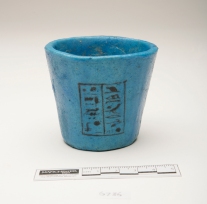Each month I hope to highlight an individual object that will feature in our new Ancient Worlds galleries. Many of the objects in the collection have incredible stories behind them but, due to an inevitable lack of space, these cannot be included fully in gallery labels or text panels. We aim to tell some of these stories – or “object biographies” – in digital content to accompany the new displays.
This small cup is only 6.75 cms in height but is made of eye-catching bright blue faience, or glazed composition ceramic. The hieroglyphs name Nesi-khonsu, wife of the Twenty-first Dynasty ruler Pinedjem II. She is given the title “first in charge of the musical troupe of Amun” (tA wrt-xnrt tp n imn) – a group of female musicians who entertained the deity in his temple at Karnak.
This piece belongs to a set of such vessels from Nesi-khonsu’s burial, intended to contain oils for use in rituals, and now scattered across several museum collections. For example, four cups from the set are in the Myers Collection of Eton College (below). Other examples are in the British Museum, the Metropolitan Museum of Art in New York and the National Archaeological Museum in Athens.
Our cup entered the Manchester collection from a 1922 Sotheby’s sale of objects collected by the Rev. William MacGregor. The accessions register lists its provenance as “Deir el-Bahri”, without giving any more detail. In fact the cup derives from one of Egyptology’s most spectacular discoveries: tomb DB320, the cache of royal mummies at Deir el-Bahri. The tomb was the family sepulchre of Nesi-khonsu’s husband, Pinedjem II of the Twenty-first Dynasty, but also contained the mummies of such famous rulers as Ahmose, Amenhotep I, Tuthmose III, Ramesses II and III. Their tombs had been robbed, so their bodies had been collected together, rewrapped and re-coffined during the Third Intermediate Period.
DB320 officially came to light in 1881, after objects from it had appeared on the art market and raised Egyptologists’ suspicions of a major find. The infamous Abd er-Rassul family of tomb robbers had known about the tomb for over a decade and only grudgingly gave up their personal treasure trove to the antiquities authorities. Once officially cleared, the tomb yielded a mass of funerary equipment of the original occupants – including Nesi-khonsu’s libation vessels. Two are shown on this photo, taken soon after the discovery.




Did Nesi-khonsu have actual musical ability herself, or did she ‘manage’ the musicians or was she a Royal patron? Is there any evidence that there was such a thing as Royal patronage?
A very good question! Personally, I imagine a bit of both. As an elite woman, Nesi-khonsu could have held the title in a purely honorary capacity. However, as the wife of the High Priest-King Pinedjem – who was no doubt actively involved in rituals at Karnak – it seems likely she may have participated herself. Whether she was any good at singing or playing a sistrum is, however, another matter.
An Egyptological reference work, The Topographical Bibliography (PM1(2), p. 665), lists at least 70 such vessels – including ours – as coming from the burial of Nesi-khonsu in DB320. That’s a lot of libations!
Reblogged this on hello future.